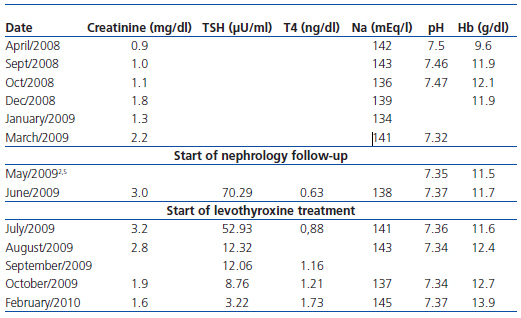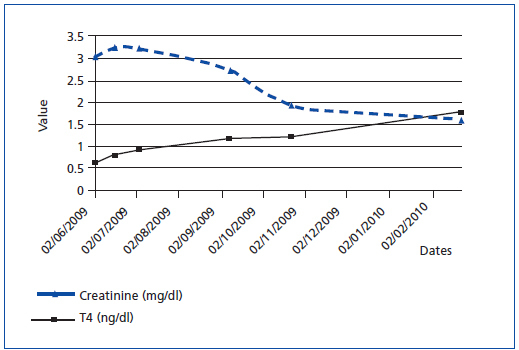Dear Editor,
The functional relationship between thyroid and kidneys has been described since the mid-twentieth century1 and has been the subject of many publications with differing pathophysiologic approaches.2-5
Here we present the case of a patient with a striking recovery of glomerular filtration rate (GFR) after correction of a diagnosed hypothyroidism. This was an 89-year-old woman with hypertension, hypertensive cardiomyopathy, atrial fibrillation (AF), mitral insufficiency, and moderate aortic insufficiency, cerebral small vessel disease, and obesity-hypoventilation syndrome. She had undergone a cholecystectomy in April 2008, with plasma creatinine in the normal range at that time.
From April 2008 and March 2009, she required several hospitalisations for episodes of rapid AF, lacunar infarct, heart failure, and digoxin toxicity. Progressive deterioration of renal function (RF) was seen until May 2009, at which point evaluation by the nephrology service was requested (Table 1). Ultrasound showed left renal atrophy (76mm diameter with corticomedullary disruption) and 118mm right kidney with moderate cortical atrophy. At that time, the patient was diagnosed with stage 4 chronic kidney disease (CKD) secondary to reduction of functional renal mass and severe cardiovascular comorbidity, with therapeutic changes consistent with the degree of CKD.
After laboratory detection of primary hypothyroidism and the subsequent diagnosis of multinodular goitre due to autoimmune thyroiditis, hormonal treatment was started with levothyroxine. In the subsequent 6 months, adequate control of hypothyroidism was seen with progressive recovery of GFR and increased haemoglobin levels, exceeding expectations of reversibility of renal impairment (Table 1 and Figure 1).
Thyroid disorders cause abnormalities in many locations with the heart and kidneys being the main targets of action of thyroid hormones.2-5 Primary hypothyroidism, which develops after intrauterine growth, is associated with impaired glomerular filtration which is reversible with hormonal treatment in approximately 55% of cases.2 Hyponatraemia is common (45% of cases with coexisting CKD versus 21% with previously normal renal function), as is fluid overload.2 Renal function deterioration secondary to hypothyroidism involves heterogenous mechanisms dominated by haemodynamic abnormalities: a negative inotropic effect on the heart, reduced circulating intravascular volume, and increased peripheral resistance with renal vasoconstriction.2-4
Among the effects of thyroid hormones are the following:
1. Gene regulation of structural and regulatory proteins such as Na+/K+ ATPase, Ca2+ ATPase, Na+/Ca2+ exchanger, betaadrenergic receptors, adenylate cyclase, phospholamban, myosin, voltage-gated potassium channels and G proteins, among others3-7
2. Extragenic regulation of Na+, K+, and Ca2+ channels in the cell membrane.3,7
3. Correlation with the reninangiotensinaldosterone system.4,6
4. Correlation with levels of argininevasopressin (ADH),4,5 brain natriuretic peptide (BNP),4,6 and plasma creatinine not dependent on renal function8 and erythropoietin.4
5. Activity on alpha-adrenergic receptor mediated vascular smooth muscle tone, activity of nitric oxide synthase (NOS), and endothelial hyperpolarising factor (EDHF).3,7
6. Thyroid hormone deficits, after foetal renal development, may manifest both as functional abnormalities and anatomic abnormalities related to the presence of immune complexes in autoimmune thyroiditis.9
7. Functional abnormalities: increased plasma creatinine, hyponatraemia, fluid retention, loss of ability to concentrate urine, and hyporegenerative anaemia.
8. Anatomic abnormalities10:
a) Glomerular: thickening of the glomerular basement membrane (GBM), amorphous mucopolysaccharide deposition in the mesangial matrix, and mesangial cell vacuolisation.
b) Tubular: thickening of the GBM, cytoplasmic inclusions in the tubular epithelium, and tubular necrosis in cases of rhabdomyolisis.
The deterioration of renal function in hypothyroidism may present with hyponatraemia, volume overload, metabolic acidosis, hypoaldosteronism relative low renin levels, rhabdomyolysis with variable proteinuria, and/or anaemia, but there is no common pattern of laboratory abnormalities. Meanwhile, CKD may cause abnormalities in the TSH circadian cycle, reduce peripheral conversion of T4 and decrease renal secretion of iodine, with prolongation of the Wolf- Chaikoff effect.2 The presence of subclinical hypothyroidism in patients with GFR less than 60ml/min is 17.9% versus 7% in patients with GFR greater than 90ml/min.2
There are numerous clinical case reports confirming the frequent association between hypothyroidism and decreased GFR, both with advanced CKD8 and in patients with preserved renal function.11 In published series of adult patients with primary hypothyroidism (Montenegro, with 41 patients12) or post-thyroidectomy (Karanikas, with 27 patients,5 Den Hollander, with 37 patients,13 Baajafer, with 124 patients,14 Kreisman, with 24 patients15) there is a reversible decline in GFR that tends to recover 6-24 weeks after correction of thyroid function. Muscular symptoms with CPK elevations were found in more than 90% of cases.8
In the case presented, the spectacular recovery of the RF after correction of hypothyroidism forced us to review our initial diagnostic impression. The advanced age of the patient with many cardiovascular risk factors, respiratory disease, and probable loss of function of the left kidney, in addition to frequent hospital admissions, made a diagnosis of multifactorial CKD very likely, with little hope of improvement. During follow-up, there were no significant ionic changes in blood or urine. No proteinuria, metabolic acidosis, or increased muscle enzymes were found. There had been no changes to the standard treatment or other causes of renal failure to which we could attribute the progression, nor was specific treatment implemented for the anaemia. Both the improvement in GFR, with the corresponding decline in serum creatinine, as well as the spontaneous increase of haemoglobin levels are primarily attributable to the hormonal correction of hypothyroidism. In our opinion, thyroid function testing is recommended as part of the diagnostic process for renal failure of undetermined cause, considering subclinical or manifest hypothyroidism among the possible causes of impaired renal function.
Table 1. Laboratory progression of plasma creatinine, TSH, T4, sodium, pH, and haemoglobin
Figure 1. Progression after stant of levothyroxine treatment.









